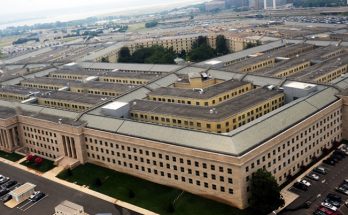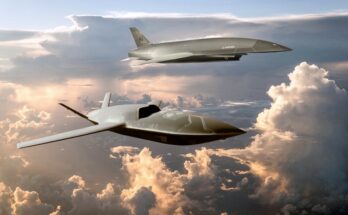
The Middle East’s share of U.S. arms imports has steadily declined, a trend largely influenced by the U.S. policy of ensuring Israel’s Qualitative Military Edge (QME). This legally mandated policy, in place since 2008, guarantees Israel a technological and strategic advantage over its neighbors. However, this approach has strained relations with key regional allies such as Egypt, Saudi Arabia, and the UAE, which seek advanced military capabilities often restricted under QME guidelines. In response, these nations have turned to alternative suppliers, including China, to meet their defense needs. CENTCOM Commander General Kenneth McKenzie acknowledged this shift in 2020, warning, “We don’t want [U.S. partners in the Middle East] turning to China, we don’t want them turning to Russia to buy those systems.”
The increase in global conflict has prompted nations to inflate their defense budgets, simultaneously developing an appetite for the latest technology. Prioritizing Israel’s QME over broader regional partnerships risks allowing China to position itself as a formidable contender in the Middle East arms market, and drastically shift the balance of power.
How QME Shapes U.S. Arms Sales
Between 2014–18 and 2019–23, the Middle East’s share of U.S. arms exports fell from 50% to 38%, according to a 2024 SIPRI report. Restrictions linked to QME are a major factor in this decline.
EGYPT
Egypt’s French Rafale fighter jets, though advanced, were delivered without crucial long-range systems such as the Meteor air-to-air missiles. Negotiations for 24 Eurofighter Typhoons from Italy, valued at $3 billion, and a potential deal with the U.S. for F-15 Strike Eagles, face similar constraints, likely omitting long-range strike capabilities to maintain Israel’s QME. Frustrated by Western limits on long-range weaponry, Egypt has increasingly sought alternative suppliers, particularly China. Beijing has offered the HD-1A supersonic cruise missile to supplement Cairo’s long-rang capability gap. With a range exceeding 180 miles (290 km) and precision targeting capabilities, the HD-1A could significantly boost Egypt’s strike capabilities. If integrated, it would challenge Israel’s QME, shifting regional power dynamics.
SAUDI ARABIA
Saudi Arabia, while the largest recipient of U.S. arms in the region, has also faced restrictions on acquiring advanced systems. After being denied access to the MQ-9 Reaper drone, the Kingdom purchased Chinese CH-4 and Wing Loong uncrewed combat aerial vehicles (UCAVs). These drones have been deployed extensively, particularly in the air campaign over Yemen. Saudi Arabia has also acquired Wing Loong II drones, which offer capabilities comparable to the phased-out MQ-1 Predator.
Another significant area involves ballistic missiles. Riyadh has acquired Chinese Dong Feng (DF) ballistic missiles, including models like the DF-3 and DF-21, after the U.S. refused to sell equivalent systems due to proliferation concerns. The Kingdom has even begun producing solid-fueled ballistic missiles domestically with Chinese technical assistance, further expanding its strategic capabilities to counter regional threats, like Iran’s missile program
Reports also suggest Saudi Arabia has engaged with China North Industries Group Corporation (Norinco) to procure advanced systems such as the Sky Saker FX80 UAV, CR500 vertical take-off and landing (VTOL) UAV, and loitering munitions like the Cruise Dragon 5 and 10.
UAE
A landmark arms agreement under the 2016 Trump administration included F-35 stealth fighters and MQ-9 Reaper drones for the UAE as part of a $23 billion package. The deal, formalized after the UAE normalized relations with Israel in 2020 under the Abraham Accords, marked a significant shift in regional defense dynamics. However, in December 2021, the UAE suspended F-35 negotiations with the Biden administration, citing “sovereign operational restrictions” related to the use and integration of the aircraft. Should such negotiations resume under Trump’s second term, the UAE would become the second Middle Eastern operator of the F-35, after Israel.
In the interim, the UAE has actively sought alternatives to bolster its capabilities. For example, China has offered Wing Loong II UCAVs. Following the hiatus of the F-35 deal from the United States, the UAE pursued alternatives to modernize its air force and enhance its military capabilities. The UAE signed a $19 billion deal with France in 2021 for 80 Rafale fighter jets, a clear pivot away from reliance on U.S. systems. These advanced 4.5-generation aircraft are set to replace the UAE’s aging fleet of Mirage 2000s while providing a modern alternative to the U.S.-manufactured F-35 stealth fighter.
Additionally, the UAE has explored opportunities with China. Reports suggest that Beijing’s Hongdu L-15 advanced trainer jet has already been delivered, raising speculation that more sophisticated Chinese platforms, such as the Chengdu J-20 stealth fighter, could be on the UAE’s wishlist.
* * *
China is positioning itself as a flexible and pragmatic alternative to Western suppliers. Unlike the United States, which imposes restrictions like the preservation of Israel’s Qualitative Military Edge (QME), China provides competitive solutions with fewer political and operational strings attached. This approach enables Beijing to capture a growing share of the arms market in the Middle East.
As U.S. arms sales face increasing scrutiny and challenges in the region, China’s proactive and adaptable strategy could redefine the regional arms trade, impacting U.S. influence and the strategic balance of power in the Middle East.
Aja Melville is an accomplished editor and analyst with expertise in open-source intelligence (OSINT) and database management. As the Weapons Editor and Analyst at Military Periscope, Aja has applied her analytical skills and in-depth knowledge in military affairs and global defense sector advancements, particularly focusing on China and the Asia-Pacific region.
Aja's commitment to international relations and Asia-Pacific focus is highlighted by her educational background. She holds a Bachelor of Arts in International Relations and Chinese Language from Bard College, complemented by a Certificate of Advanced International Studies from the Bard Globalization and International Affairs Program. Aja further expanded her linguistic skills with a Certificate of Intensive Language Studies in Chinese (Mandarin) from Qingdao University.




